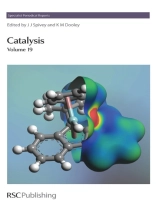There is an increasing need to find cost-effective and environmentally sound methods of converting natural resources into fuels, chemicals and energy; catalysts are pivotal to such processes. Catalysis highlights major developments in this area. Coverage of this Specialist Periodical Report includes all major areas of heterogeneous and homogeneous catalysis. In each volume, specific areas of current interest are reviewed. Examples of topics include experimental methods, acid/base catalysis, materials synthesis, environmental catalysis, and syngas conversion. Catalysis will be of interest to anyone working in academia and industry that needs an up-to-date critical analysis and summary of catalysis research and applications. Specialist Periodical Reports provide systematic and detailed review coverage in major areas of chemical research. Compiled by teams of leading experts in their specialist fields, this series is designed to help the chemistry community keep current with the latest developments in their field. Each volume in the series is published either annually or biennially and is a superb reference point for researchers.
Table of Content
Chapter 1: Promotion Effects on Co-based Fischer-Tropsch Catalysis; 1: General Introduction; 1.1: Fischer-Tropsch Synthesis; 1.2: Scope of the Review Paper; 2: Fischer-Tropsch Catalysis; 2.1: Gas-to-Liquid Technology, Economic Impact and its Relevance to Society; 2.2: Fischer-Tropsch Catalysis; 3: Co-based Fischer-Tropsch Catalysts; 3.1: Promotion Effects; 3.2: Overview of the Promoter Elements used in Co-based F-T Catalysis; 4: Mn-promoted Fischer-Tropsch Catalysts; 4.1: Mn-promoted Fe-based Fischer-Tropsch Catalysts; 5: Concluding Remarks and Outlook; Acknowledgements; References and Notes; Chapter 2: The Catalysis of Biodiesel Synthesis; 1: Introduction; 2: Overview; 2.1: Vegetable Oils and Animal Fats; 2.2: Reactions; 2.3: Physicochemical Properties of Biodiesel; 2.4: The Feedstock Issue; 2.5: Processing Methodologies; 3: Homogeneous Catalysis; 3.1: Base-catalyzed Synthesis; 3.2: Acid-catalyzed Synthesis; 3.3: Integrated Acid-Base Biodiesel Synthesis; 3.4: Existing Problems with Homogeneous Catalysts; 4: Heterogeneous Catalysis in Biodiesel Synthesis; 4.1: Catalysis by Metals, Metal Compounds and Supported Metal Complexes; 4.2: Catalysis by Solid Bases; 4.3: Catalysis by Solid Acids; 4.4: Potential Problems with Heterogeneous Catalysts; 5: Conclusions and Future Perspectives; References; Chapter 3: Catalysis with Nitrides and Oxynitrides; 1: Introduction; 2: Preparation of Nitride and Oxynitride Catalysts; 3: Catalytic Reactions with Nitrides and Oxynitrides; 3.1: Ammonia Synthesis, Ammonia Decomposition and Hydrazine Decomposition; 3.2: Amination and Ammoxidation; 3.3: NO Removal; 3.4: Hydrotreating and Hydrogenation; 3.5: Base Catalysis; 3.6: Photocatalysis; 3.7: Use as Supports; 3.8: Hydrogen Storage; 4: Conclusions and Outlook; Acknowledgements; References; Chapter 4: Kinetics of Surface Reactions with Lateral Interactions: Theory and Simulations; 1: Introduction; 2: Basics of Lateral Interactions; 2.1: The Mechanism of Lateral Interactions; 2.2: Equilibrium Aspects; 2.3: Effect on Lateral Interactions on the Kinetics; 3: Theory; 3.1: Including Lateral Interactions in the Kinetics; 3.2: Analytical Expressions for Lateral Interactions; 3.3: Experimental Determination; 3.4: Calculating Lateral Interactions; 4: Examples; 4.1: NO/Rh(111); 4.2: Sulfate on Fcc(111) Surfaces; 4.3: CO/Rh(100); 4.4: O/Pt(111); 4.5: Tartaric Acid on Cu(110); 5: Outlook; Acknowledgements; References; Chapter 5: Methane Decomposition: Production of Hydrogen and Carbon Filaments; 1: Introduction; 2: Hydrogen Production; 2.1: Catalytic Decomposition of Methane for Hydrogen Production; 2.2: Step-wise Methane Reforming: Regeneration Issues; 3: Production of Carbon Filaments by Catalytic Methane Decomopsition; 3.1: Ni-based Catalysts; 3.2: Fe and Co-based Catalysts; 4: Concluding Remarks; References; Chapter 6: Catalytic Reforming of Liquid Hydrocarbon Fuels for Fuel Cell Applications; 1: Introduction; 1.1: Demands for Fuel Reforming Technology; 1.2: Applications/Types of Reforming; 1.3: Issues; 1.4: Scope of this Chapter; 2: Deactivation; 2.1: Carbon Deposition; 2.2: Sulfur Poisoning; 3: Steam Reforming; 3.1: Thermodynamics; 3.2: Catalysts; 4: Partial Oxidataion; 4.1: Thermodynamics; 4.2: Catalysts; 5: Autothermal Reforming; 5.1: Thermodynamics; 5.2: Catalysts; 5.3: Exhaust Gas Reforming; 6: Pyrolysis/Cracking; 7: Plasma-Assisted Reforming; 7.1: Non-Thermal Plasma; 8: Supercritical Reforming; 9: Prereforming; 10: Kinetics; 10.1: Reactivity of Hydrocarbons; 11: Concluding Remarks; ReferencesAbout the author
Professor Spivey is the Mc Laurin Shivers Professor of Chemical Engineering at Louisiana State University and Director of the DOE Energy Frontier Research Center at LSU. Professor Spivey’s research interests include the application of the principles of heterogeneous catalysis to catalytic combustion, control of sulfur and nitrogen oxides from combustion processes, acid/base catalysis (e.g., for condensation reactions), hydrocarbon synthesis, and the study of catalyst deactivation.
Language English ● Format PDF ● Pages 268 ● ISBN 9781847555229 ● File size 4.5 MB ● Editor James J Spivey & K M Dooley ● Publisher Royal Society of Chemistry ● Published 2007 ● Edition 1 ● Downloadable 24 months ● Currency EUR ● ID 5495986 ● Copy protection Adobe DRM
Requires a DRM capable ebook reader












